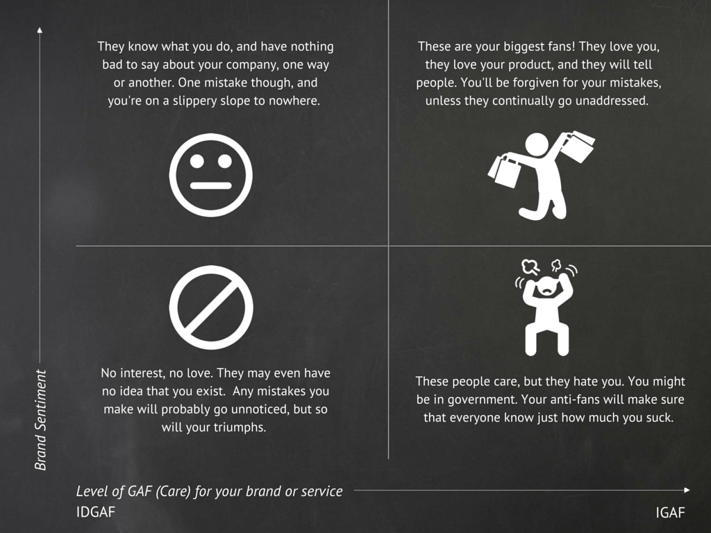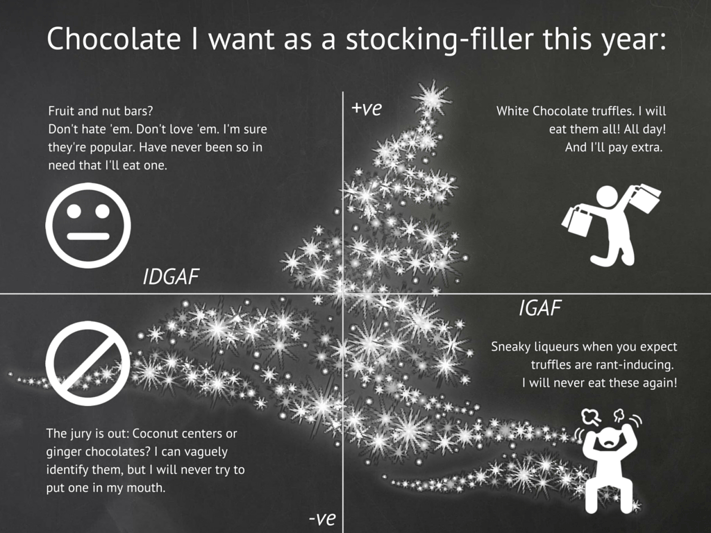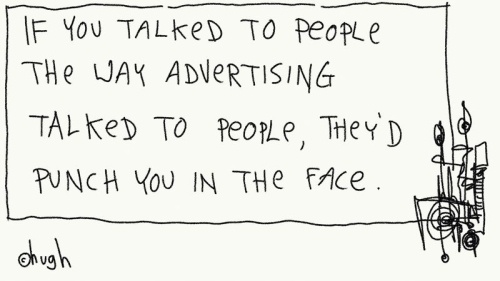 Ah, Christmas: The season of giving and the most wonderful time of the year. For brands, it’s the season of advertising, promotion, specials, and more advertising.
Ah, Christmas: The season of giving and the most wonderful time of the year. For brands, it’s the season of advertising, promotion, specials, and more advertising.
We know you need to draw in customers, and that the competition around this time of year is stiff – so stiff, in fact, that there seems to be very little wiggle-room to get your message out there.
Consumers are already being bombarded with (sometimes intrusive, often irrelevant, potentially annoying) Christmas messaging.
We already know that consumers are overloaded.
We know that consumers are exhausted.
We know that consumers are concerned about holiday debt.
We also know we’re about to start irritating the hell out of them.

You're getting under your consumer’s skin: how to gauge if that's a good thing.
There are very few things that annoy audiences more than never-ending, intrusive marketing ploys, and at Christmas, the numbers seem to soar. While we have our reasons for doing it, marketers come under fire every year for the advertising mistakes they make over the holidays.
This is the GAF quadrant. We work out where brands or products fall based on two axes:

X: How much of an F they give about your brand, service, or product. Imagine that chocolate, always a high scorer, is at the top of the scale. A sweet that nobody cares about or notices would fall into the opposite end – like generic gums.
Y: The sentiment that consumers feel about the product. Everybody LOVES chocolate, in CAPSLOCK, right? So chocolate goes top right, right? Not always.
For a simpler picture, let’s break down the different types of chocolate specifically, according to where they fall on the GAF scale, under the chocolate umbrella (which sounds delicious and useful):

Disappointing service, products, and bad advertising will take you from a far more favourable quadrant to the no-fly zone: 'I hate your product, and will tell everyone'.
Try to be your customers’ truffles (and give out as few accidental liqueurs as you possibly can) by following these 7 guidelines:
Everybody makes marketing mistakes at this time of year.
What are they, and how can you minimise the consumer de-clutch that comes with the Christmas crush?

1. Speaking to the wrong need-state
Notice anything weird about the imagery in the quote we placed above?
That’s right. This is South Africa. The day that snow is relevant to Christmas here is the day that pigs take off from the snow-covered trees, and fly straight into our gammon pots. We don’t need ugly jerseys or sleighs, and we definitely don’t want them, because the heat is excessive at this time of year. That said, we don’t want Santa in a speedo either, so be careful with this advice.
If you market your product in the same way that people continue to portray Christmas in the southern hemisphere (with little to no consideration of the actual environment), you’re gonna have a bad time*.
*For example, if you choose to market a diabetic ice-cream to the masses in a mall, where the majority of people are looking for full-cream Neapolitan bulk-tubs, your feedback is going to be ‘Ugh’ - and very little else.
Tip: Get vernacular. Get cultural. Get personal. Get business. People don’t think in terms of categories or brands; they think in terms of wants and needs. Find the human truth in your product, and go for it.
2. Patronising your audience
Consumers have heard it all. In fact, they’ve heard so much that they’ve travelled through the spectrum and have popped out at ‘no longer hearing anything’. When messaging gets through, the tone and actual offer need to resonate, and not offend or irritate the customer. When your audience feels like you’re patronising them, dumbing down your message, or actively speaking slowly, they slide a little down the positive axis of the GAF scale.
Tip: Just say it and mean it, without undermining the intelligence or capacity of your audience. There is no space in the festive frenzy for daft messaging.
3. Overdoing the sentimentality
Christmas is a great excuse to tug on heartstrings. Sometimes, done well, it’s a magical and emotional experience. Most of the time, it’s an excruciating 30-second wait wishing you’d taken a bathroom break.
Bob Geldof made this mistake in 2014, when he revived the overly-sentimental, syrupy ‘Do they know it’s Christmas’ to raise funds for the Ebola effort in Sierra Leone, Guinea, and Liberia.
After painting a picture of Africans across the continent suffering while the world watched, the responses varied between ‘Yes, Bob, they know it’s Christmas’, ‘Do some research’ and ‘WTF?’.
Sentiment and emotion are two different things.
- Sentiment is a laboured misrepresentation of the feelings you feel people should have – which, in advertising, equates to bad targeting.
- Emotion is the result of a well-thought out, well-written concept that resonates with your audience.
Tip: Don’t make your consumers fetch a barf-bag. Keep your communication honest and targeted, so that the emotion you elicit is genuine and effective.
4. Bombarding them online
Online sales are up this year – great news for online retailers! However, online pop ups, terrible targeting, and forced eyeballing of Bikini Beach Body ads are also, sadly, skyrocketing, necessitating the use of adblockers and filters on users’ web browsers.
Imagine your consumer browsing your website for the information they need. Now imagine a pop-up ad about their winter flab following them wherever they go. How long do you suppose they’ll keep pushing through? Chances are, they will give up on your site and take their business elsewhere.
Tip: Make it easy for consumers to travel your site, and help them get the information as quickly as possible. Reward your consumers for actively engaging and educating themselves. After all, a consumer that knows everything about you sounds a whole lot like a ‘fan’.

5. Bombarding them in real life
Once a consumer has reached the mall, there is no going back for them. They’ve arrived, and best they brave the crowds, remember what they were going to buy, keep track of their children, and not lose their car if they want to get out alive.
It’s that bad – what could possibly make it worse?
Well… you know the ladies who set up their stations in the middle of the walkway, and almost rugby-tackle consumers to sell hand-scrubs? Or the kind promo-girls who spray perfume on passers-by without permission?
You get the picture.
Tip: Help, don’t hinder. Provide a service or promotion that can soothe and assist your mall-weary customers. Make them remember you for the great things you did, not avoid you for the foreseeable future.
6. Having a great promo, but letting your service slip
You have a great deal. You will sell millions of units this Christmas!
BUT:
Your salespeople have no idea what the special is, which stores it’s available at, or what it applies to.
You do not sell millions of units.
Tip: Service and specials must match up. Ensure your staff are briefed and understand the plan. Communicate clearly with customers, so that they know where to go. Help yourself by helping them .
7. Trying to speak to everyone about everything
We know how it feels being bombarded by advertising that is completely irrelevant. It happens throughout the year. At Christmas time, it escalates, and the amount of noise we take on can cancel out the effect of really valuable messaging.
Tip: Keep your targeting on track. Don’t betray your strategy because it’s Christmas, and ensure the people who want to hear you, can.

In short, your main aim should be to cut through the noise of the holidays with really useful, straightforward messaging, allowing your consumers to simply absorb and understand your offers.
You don't have to do what works for everybody else.

Going against the grain may sound like a terrible idea, but your consumers, who are having a pretty rough year, will thank you.
For more holiday marketing tips that may or may not include colourful language, subscribe to our blog.







SUBMIT YOUR COMMENT